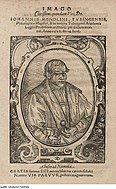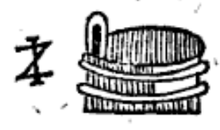Jakob Züberlein
Jakob Züberlein (born February 26, 1556 in Heidelberg , † before October 15, 1607 in Tübingen ) was a German painter .
Life
After Hans Ulrich Alt received the order from Duke Ludwig von Württemberg in the last half of the 16th century to make paintings by Tübingen professors, Jakob Züberlein signed them so that the Tübingen shape cutter Joachim Lederlin could make woodcuts on pear wood.
In 1596 the Tübingen professor and publisher Erhard Cellius published a book with 37 woodcuts by Jakob Lederlein in Tübingen. These were based on preliminary drawings by Elias Alzius and Jakob Züberlein as well as paintings by Anton Ramsler and Philipp Renlin . They show the professors then teaching in Tübingen in a frame, mostly behind a parapet and often with a book in their hands and sometimes with attributes of their discipline, often similar to the oil paintings in the Tübingen professors' gallery .
Works
Jakob Züberlein painted the Öhrn in the Tübingen town hall in 1596 , copying paintings by Heinrich Füllmaurer (1526–1546), e. B. that of a Catholic clergyman who overlooks the beam in his own eye. He also made paintings for a Bamberg church. In 1591 he had painted an oriel in the apartments of Duke Ludwig in the old castle in Stuttgart and received 130 fl . In addition, he made two monumental pictures for the premises there, for which he was paid 550 fl.
Erhard Cellius , professor of eloquence, poetry and history
Johann Halbritter , Professor of Law
Johannes Mendlin (1505–1577), professor of logic.
monogram
His monogram was a capital I in front of a slightly smaller Z and next to it a wooden washtub.
literature
- Julius Baum : Züberlein, Jakob . In: Hans Vollmer (Hrsg.): General lexicon of fine artists from antiquity to the present . Founded by Ulrich Thieme and Felix Becker . tape 36 : Wilhelmy-Zyzywi . EA Seemann, Leipzig 1947, p. 580-581 (with further references).
- Heinrich Geissler : Züberlein, Jakob. In: Jane Turner (Ed.): The Dictionary of Art . Volume 33, Grove, New York 1996, ISBN 1-884446-00-0 , pp. 711-712.
Web links
- Portrait of Iacobus Schegkius - Züberlein, Jakob, draftsman, form cutter, 1590 portraitindex.de
- Züberlein, Jacob zeno.org
Individual evidence
- ↑ Alzius (Elias), actually Eilas Alt. In: Johann Heinrich Füssli: New additions to the general artist lexicon. Issue 1, Orell, Füssli and Compagnie, Zurich 1824, pp. 113–114 ( books.google.de ).
- ^ The Tübingen Professors' Gallery . on LEO-BW.
- ^ Andrea Bachmann: Tübinger streets: The Füllmaurerstraße. ( Memento from September 24, 2015 in the Internet Archive ) In: Tagblatt Anzeiger from March 17, 2010.
- ↑ National Guard Almanac for the Kingdom of Bavaria. 1811. Attenkover, Ingolstadt 1811, p. 113 ( books.google.de ).
- ↑ Annegret Kotzurek: Brief history of the old castle in Stuttgart . DRW-Verlag, Leinfelden-Echterdingen 2003, p. 31.
- ↑ Photo archive Marburg
- ↑ Mendlin Johannes leo-bw.de.
- ↑ Joseph Heller: History of the art of wood cutting from the oldest to the most recent times: together with two supplements, containing the origin of the playing cards and a list of all xylographic works. CF Kunz, Bamberg 1823, p. 207 ( books.google.de ).
| personal data | |
|---|---|
| SURNAME | Züberlein, Jakob |
| ALTERNATIVE NAMES | Zuberlin, Jakob; Zaberlin, Jakob; Ziberlen, Jakob; Zuberlin, Jakob; Züberlin, Jakob; Züberlein, Jacob |
| BRIEF DESCRIPTION | German shape cutter |
| DATE OF BIRTH | February 26, 1556 |
| PLACE OF BIRTH | Heidelberg |
| DATE OF DEATH | before October 15, 1607 |
| Place of death | Tübingen |




